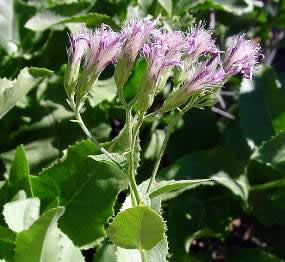Biological Survey of Ironwood Forest National MonumentVascular Flora By Thomas R. Van Devender, John F. Wiens, and Mark Dimmitt
The flora was compiled by intensively surveying almost 200 ca. 5-hectare (12-acre) plots representing all habitat types and geographic areas of the monument (see plot map). Additional sites were surveyed less intensively to record dominant and rare plants. Lastly, several thousand individual records of interesting or rare plants were entered from our own and historical observations from herbaria and published floras. The documented flora currently stands at 560 taxa in 308 genera and 80 families. There are 540 binomial species, seven species with two varieties or subspecies each, and 13 hybrids. Of these, 271 taxa (48.4%) are uncommon, rare, or of limited distribution. The families with the most taxa are Asteraceae (86), Poaceae (79), Fabaceae (36), Cactaceae (29 plus 12 hybrids), Malvaceae (23), and Euphorbiaceae (23; Figure 8). The IFNM genera with the most taxa are Euphorbia (16), Cylindropuntia and Opuntia (8 species + 7 varieties + 12 hybrids), Eriogonum (11), Boerhavia (8), and Ambrosia (7+ 1 hybrid). |
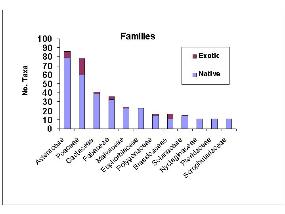 Number of taxa in the 12 most common families in the IFNM flora |
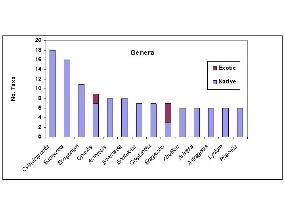 Number of taxa in the 14 most common genera in the IFNM flora |
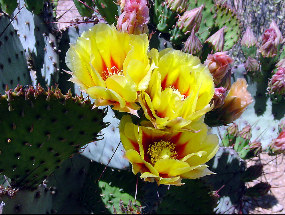 Click image for a gallery of cacti. |
If all the opuntioids were included in the genus Opuntia as they often are, they would comprise the largest genus with 27 taxa (including Grusonia parishii syn. Opuntia stanlyi, Corynopuntia parishii). Compared with the flora of the Tucson Mountains 20 miles to the west, IFNM has more taxa of cacti but a lower density (Rondeau et al. 1996). Even by splitting up the opuntioids the genus Cylindropuntia is in top rank with 18 taxa.
Fifty-four exotic species occur in the Monument, comprising 9.6% of the IFNM flora. Some of these are "native-exotics", plants that occur naturally nearby but have been introduced to the Monument. Others are from distant places, and some are invasive and pose serious threats to the ecological integrity of the biological community.
The major lifeforms are 4 ecologically important native trees (0.7% but visually the second-most dominant lifeform after columnar cacti), 322 perennials (57%), and 238 annuals (43%). We omitted from the tree lifeform a few rare species that can be trees but attain only shrub size in IFNM, e.g., shrub live oak and western soapberry. We also did not count cottonwood and willow (one or two specimens of each) that may have been planted and are not functional components of the biological community. Also uncounted were three exotic tree species: a single planted eucalyptus tree and two species of saltcedar that are locally common at two disturbed sites. At this time these exotic trees are not ecologically important in the vast majority of the National Monument’s area.
Legumes are the dominant family in the dry tropics (Gentry 1995, Van Devender et al. 2000). Composites are typically dominant in the temperate zone, as they are in IFNM. About half of the total Sonoran Desert flora is largely derived from thornscrub and tropical dry forest to the south (Dimmitt 2000b). We interpret the dominance of composites in IFNM as a consequence of the fact that Arizona Upland is higher and cooler than the other Sonoran Desert subdivisions, and therefore has fewer tropical elements.
All three Southwestern plants commonly known as crucifixion thorns occur in the Monument. All are essentially leafless, extremely thorny shrubs. They are unrelated to one another; each species belongs to a different family. Their superficial similarity is an example of convergent evolution.
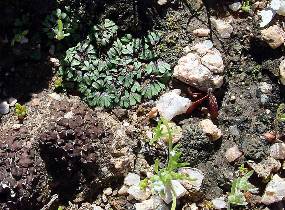 Biological soil crusts are rarely surveyed but have crucial importance to desert ecosystems. Many species of lichens, algae, fungi, and liverworts bind the soil surface and fix nitrogen that enriches the environment with this limiting nutrient. They are often brown to black in color or exist just below the surface and are thus nearly invisible. Most desert soils are crusted, and the crust is usually biological in origin. When disrupted (usually by human activities) the exposed unbound soil is susceptible to erosion, and nitrogen fixation is reduced which in turn limits plant growth. Sonoran Desert soil crusts typically recover quickly unlike those in the Mohave Desert, but frequent disturbance can eventually impoverish communities even if the plants are not physically harmed.
Biological soil crusts are rarely surveyed but have crucial importance to desert ecosystems. Many species of lichens, algae, fungi, and liverworts bind the soil surface and fix nitrogen that enriches the environment with this limiting nutrient. They are often brown to black in color or exist just below the surface and are thus nearly invisible. Most desert soils are crusted, and the crust is usually biological in origin. When disrupted (usually by human activities) the exposed unbound soil is susceptible to erosion, and nitrogen fixation is reduced which in turn limits plant growth. Sonoran Desert soil crusts typically recover quickly unlike those in the Mohave Desert, but frequent disturbance can eventually impoverish communities even if the plants are not physically harmed.









